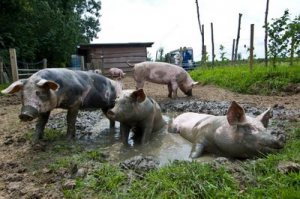

One of the most well-known, natural behaviors of pigs is wallowing. Happy pigs and mud seem to go hand in hand, but what is it that drives a pig to seek mud, and what makes it so enjoyable?
The main reason it is suspected that pigs appreciate a good wallowing is due to temperature regulation. Pigs have very few sweat glands, which makes body heat regulation through sweating difficult. Water can be used to cool a pig, but it simply does not have the same lasting affect that mud does. While water evaporates quickly off of the skin, it takes a longer period of time for the water in mud to evaporate, thus keeping the pig cooler, longer. Pigs also wallow in cold temperatures, however, so what is the explanation behind that? It is possible that cold weather wallowing allows mud to become an insulating layer to allow body heat to be more easily retained.
Another explanation for wallowing is protection from the sun. Covering their bodies in a layer of mud will protect them from the sun’s potentially harmful, burning rays.
Also possible is that mud is a useful tool in the battle against parasites and biting insects. If a tick were to attach itself to a pig that wallows, that tick will not be able to breathe and will have no choice but to release its bite or die. Lice are another parasite that cannot survive being trapped beneath mud. A thick layer of mud also presents an obstacle for biting insects, such as flies. If flies are unable to bite pigs due to the mud barrier, they have no choice by to move on and search for an easy meal elsewhere.
It has even been suggested that wallowing may serve as a means of territorial marking. This could apply not only to domestic pigs but also to feral pigs who want to make their presence known. When wallowing, pigs may rub their scent glands in and around the wallowing area to declare it to be their own.
Modern farming has in some cases taken wallowing away from the pig, placing pigs instead in air conditioned barns to keep them cool and treating them with medications to keep them parasite free. While this likely has advantages, it also has disadvantages and can lead to an unnatural environment in which pigs may not thrive in quite the same manner as they do when given what is, to them, a natural life. It may also be frustrating on both parts, that of humans and that of pigs, to attempt to change the way a pig is wired by removing its ability to conduct behaviors that come naturally to it.
Do you allow your pigs to wallow? Have you designated a mud hole for them and, if so, do they partake regularly? By many accounts, wallowing is beneficial to pigs and providing an opportunity for them to do so lends to their overall welfare. Wallowing is not a behavior exclusive to pigs, making it highly possible that the benefits of it are seen by other species (elephants, deer, and rhinoceros are also known to wallow) so perhaps we as humans should take their word for it that wallowing is a good thing and allow them the opportunity to do so.
 Contact Jaguza Support
Contact Jaguza Support